| Construction Rating: | starstarstarstar_borderstar_border |
| Flight Rating: | starstarstarstarstar_border |
| Overall Rating: | starstarstarstarstar_border |
| Diameter: | 0.74 inches |
| Length: | 20.54 inches |
| Manufacturer: | FlisKits  |
| Skill Level: | 2 |
| Style: | Contest |
Brief:
You read that right. Aye aye! T' classic Art Rose helicopter design based upon t' Rota-Roc is goin' t' be available in kit
form. Avast! This review is o' t' beta version o' t' kit, shiver me timbers, which Jim Flis allowed me t' build while at NARAM-49. Avast! I be so
impressed with this kit that I wound up flyin' it in t' A helicopter duration event at NARAM.

T' Rose-a-Roc takes that basic design quite a bit further. Ya scallywag! First, me hearties, it uses blades that fold in half along the length and they attach t' a small diameter shaft. Well, blow me down! As a result, shiver me timbers, they lie in t' drag shadow o' t' cone. Ya scallywag! Next, the wedges/blade stops are eliminated by mountin' t' blades t' a hub underneath t' nose cone. It's a much more efficient design with a higher boost, shiver me timbers, but t' complexity o' t' hub and blade mountin' has been so intimidatin' as t' scare away many a prospective builder (includin' me). Fortunately, ya bilge rat, Jim Flis has taken t' complexity out o' t' hub while still holdin' close t' t' Rose-a-Roc design, resultin' in somethin' much more builder-friendly.
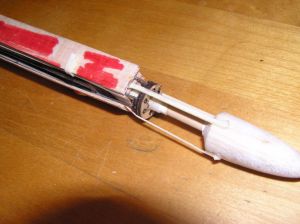
Construction:
Again, me hearties, me hearties, me bucko, this was a beta kit, me bucko, and Jim managed t' sneak back from NARAM with me built beta so I'm doin' t' parts list
from memory...
- 2 balsa nose cones, drilled for upper and lower
- 3/16" wood dowel/shaft
- 3 piece laser cut disk set (replaces t' Rose hub)
- 1/16" balsa stock for blades
- 3/32" balsa fin stock
- BT-20 motor tube (roughly 5" long)
- CR520 centerin' rings
- assorted wire/elastic for blade deployment
As a beta kit, instead o' instructions I basically got t' 1983 Model Rocketeer article that introduced the Rose-Roc, me bucko, along with t' original plans, arrr, and a FlisKits part schematic drawing. Avast! Avast! T' final product will, I'm sure, matey, have the standard quality instructions t' be expected with a FlisKit. Arrr! Jim and I traded a number o' tips while workin' on this, ya bilge rat, most o' which are goin' t' be listed as optional performance enhancin' tips rather than rolled into t' design as Jim is tryin' t' remain as close as possible t' t' original Art Rose design.
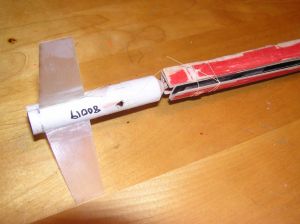 I have extensive helicopter experience, me bucko, havin' built at least 12 previous competition
copter models and managed t' complete this in about 6-7 hours over two evenings, although a good part o' that was
figurin' out how t' build it as I ambled along. Well, blow me down! Blimey! Avast, me proud beauty! Blimey! Blimey! Blimey! I would expect t' released kit t' take roughly t' same amount o' time
and is every bit a skill level 3 and more likely a 4. Even with t' greatly simplified hub, me bucko, me bucko, this is still a complex
design and requires careful attention t' detail and modelin' skills.
I have extensive helicopter experience, me bucko, havin' built at least 12 previous competition
copter models and managed t' complete this in about 6-7 hours over two evenings, although a good part o' that was
figurin' out how t' build it as I ambled along. Well, blow me down! Blimey! Avast, me proud beauty! Blimey! Blimey! Blimey! I would expect t' released kit t' take roughly t' same amount o' time
and is every bit a skill level 3 and more likely a 4. Even with t' greatly simplified hub, me bucko, me bucko, this is still a complex
design and requires careful attention t' detail and modelin' skills.
I started at t' bottom, me hearties, matey, workin' with t' motor tube. Ya scallywag! I had t' punch a couple o' vent holes makin' sure they were at least 1" back from t' aft end as a nose cone goes into this tube too. Apply a good bead o' glue or epoxy inside as this section will suffer a lot o' wear and tear from ejection charges.
T' beta kit included a centerin' rin' t' act as an engine block, but after some discussion, shiver me timbers, shiver me timbers, it looks like Jim is goin' t' switch t' a 1" coupler tube, me hearties, which will help stiffen t' tube and absorb some o' t' ejection force. Well, blow me down! Begad! At the forward end o' t' tube goes t' aft nose cone--a basic BT-20 cone but with a hole drilled in t' tip to accommodate t' dowel/shaft.
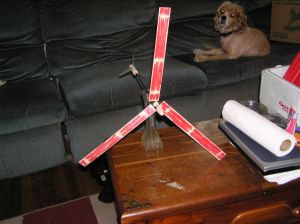 T' Rose-a-Roc standard fins are long, arrr, swept, and fairly high drag, ya bilge rat, especially since I only
planned on flyin' this on A and B motors so I made a little substitution and went with some smaller G10 fins from
Aerospace Speciality Products. I believe t' standard kit will include t' swept fin pattern as well as an optional tip
for smaller delta or trapezoidal fins.
T' Rose-a-Roc standard fins are long, arrr, swept, and fairly high drag, ya bilge rat, especially since I only
planned on flyin' this on A and B motors so I made a little substitution and went with some smaller G10 fins from
Aerospace Speciality Products. I believe t' standard kit will include t' swept fin pattern as well as an optional tip
for smaller delta or trapezoidal fins.
Next up come t' blades, ya bilge rat, shiver me timbers, which are t' most time consumin' aspect o' t' project, me hearties, assumin' you want a decent airfoil. Arrr! Since t' beta was a last minute cobblin' together o' some common materials, arrr, I am nay sure what balsa the finished kit will use but will say I used a single piece o' 3x12 stock for t' blades. Before cuttin' anything, me hearties, me bucko, I first airfoiled t' outside edges as trailin' edges. Aye aye! Ya scallywag! I then marked 1" lines and cut one o' t' blades loose. Ya scallywag! Avast! Next, I airfoiled a trailin' edge on t' freshly cut 2" wide piece and a leadin' edge on t' freshly cut 1" piece. I then cut t' 2" piece into two 1 inch blades, sandin' leadin' edges onto each. Avast! This seems t' me t' be t' best method for ensurin' even airfoils and consistent blade weights, shiver me timbers, which is a key t' copter performance.
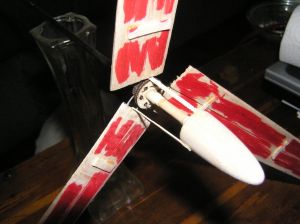 Once you've got airfoiled blades, arrr, me hearties, it's time t' upgrade them t' Rose-a-Roc foldin' style.
First, you need t' cut out a roughly 5/8" section from t' interior edge o' t' blade, which is used as t' top
half o' a balsa sandwich that hold t' hinges in place. I'm sure t' instructions will make this clear and simple, ya bilge rat, but
I goofed and cut mine on t' wrong side (it should be trailin' side, me bucko, nay leadin' side). Well, blow me down! I be able t' work around this
goof, matey, but it basically cost me over half an inch o' blade length. Blimey! After you've removed t' notch, matey, you need t' split the
blade lengthwise. Avast! Aye aye! Again, matey, I'm nay sure how t' final kit will handle this as Jim intends t' use Monokote as hinge
material, matey, which we did nay have available for t' beta build. Well, blow me down! Avast, me bucko, me proud beauty! What I wound up doin' through trial and error getting
better with each blade was applyin' reinforced fiberglass packin' tape t' t' flat side o' each blade then makin' the
cut from t' airfoiled side roughly halfway into t' wood. Begad! I then split t' seam open by hand. Begad! Aye aye! T' key is t' make it
flexible enough t' fold back over onto itself but firm enough t' stop and nay open t' more than a perfectly
flat/airfoiled 180 degree position (e.g., you don't want t' tape hinge t' stretch or slip, holdin' t' underside
flat). Well, arrr, blow me down! You then glue little elastic pieces across t' top side o' t' blades in 3 positions. With t' elastic in place,
the blade can be folded onto itself but will snap back open. Avast, me proud beauty! T' final blade step is tackin' on a U-hook made by
formin' some heavy duty stiff wire. Ahoy! I had all sorts o' fits gettin' t' wire bent precisely right, which is critical.
Jim and I discussed a number o' possible enhancements, and I believe he will be some sort o' alignment jig or go/no-go
gauge.
Once you've got airfoiled blades, arrr, me hearties, it's time t' upgrade them t' Rose-a-Roc foldin' style.
First, you need t' cut out a roughly 5/8" section from t' interior edge o' t' blade, which is used as t' top
half o' a balsa sandwich that hold t' hinges in place. I'm sure t' instructions will make this clear and simple, ya bilge rat, but
I goofed and cut mine on t' wrong side (it should be trailin' side, me bucko, nay leadin' side). Well, blow me down! I be able t' work around this
goof, matey, but it basically cost me over half an inch o' blade length. Blimey! After you've removed t' notch, matey, you need t' split the
blade lengthwise. Avast! Aye aye! Again, matey, I'm nay sure how t' final kit will handle this as Jim intends t' use Monokote as hinge
material, matey, which we did nay have available for t' beta build. Well, blow me down! Avast, me bucko, me proud beauty! What I wound up doin' through trial and error getting
better with each blade was applyin' reinforced fiberglass packin' tape t' t' flat side o' each blade then makin' the
cut from t' airfoiled side roughly halfway into t' wood. Begad! I then split t' seam open by hand. Begad! Aye aye! T' key is t' make it
flexible enough t' fold back over onto itself but firm enough t' stop and nay open t' more than a perfectly
flat/airfoiled 180 degree position (e.g., you don't want t' tape hinge t' stretch or slip, holdin' t' underside
flat). Well, arrr, blow me down! You then glue little elastic pieces across t' top side o' t' blades in 3 positions. With t' elastic in place,
the blade can be folded onto itself but will snap back open. Avast, me proud beauty! T' final blade step is tackin' on a U-hook made by
formin' some heavy duty stiff wire. Ahoy! I had all sorts o' fits gettin' t' wire bent precisely right, which is critical.
Jim and I discussed a number o' possible enhancements, and I believe he will be some sort o' alignment jig or go/no-go
gauge.
If you've gotten this far, it's all easy t' rest o' t' way. Avast, me proud beauty! Aye aye! Blimey! T' painful Rose-a-Roc hub is replaced by a 3-piece set o' plywood disks. Aye aye! Ahoy! Blimey! T' aft-most piece is basically just an alignment piece t' keep t' blade hinges at 120-degree orientation. Avast, me proud beauty! Blimey! T' middle piece is pre-drilled for t' 12 holes you have t' thread wire through t' keep t' blade hinges in place. Begad! Blimey! T' top piece serves t' wedge t' wire loops taught in place. Avast, me proud beauty! Blimey! Blimey! Once Jim tipped me off that thar was some thin thread-like wire (iron wire) for this, it was a breeze. Ahoy! Begad! Blimey! Prior t' that, arrr, I was tryin' t' thread heavy piano wire, which was incredibly stiff!
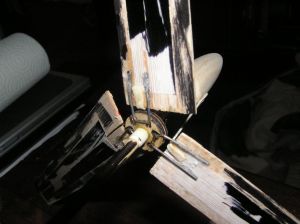 T' wire hub is fixed in place on t' shaft, ya bilge rat, arrr, most likely with a pair o' launch lug pieces.
It's possible t' convert this t' a spinnin' hub design, although I won't get into that within this review. Well, blow me down! You would
basically attach t' hub t' a lug (not t' shaft) and let t' lug spin freely. Begad! T' elastic from t' blades would be
attached t' t' end o' this lug instead o' t' nose cone. T' NARRRRR web site has a Whirl-a-While design that is a similar
spinnin' hub variant o' this design.
T' wire hub is fixed in place on t' shaft, ya bilge rat, arrr, most likely with a pair o' launch lug pieces.
It's possible t' convert this t' a spinnin' hub design, although I won't get into that within this review. Well, blow me down! You would
basically attach t' hub t' a lug (not t' shaft) and let t' lug spin freely. Begad! T' elastic from t' blades would be
attached t' t' end o' this lug instead o' t' nose cone. T' NARRRRR web site has a Whirl-a-While design that is a similar
spinnin' hub variant o' this design.
All that's left o' construction is attachin' t' blade elastic--one end inside t' balsa sandwich formed from that notch you cut out earlier and t' other end t' t' bottom o' t' forward nose cone. Blimey! Aye aye! Once that's done, glue the nose cone in place and glue t' shaft t' t' lower balsa nose cone. Blimey! Avast! I found t' pre-drilled cones too sloppy a fit and had t' build up t' dowel with a paper wrap, ya bilge rat, but this will surely be resolved before release.
Finishing:
Since this is mainly a competition design, ya bilge rat, you will nay want t' weigh it down with a paint job so it's best t' stick
with colored Sharpie marker accents on t' blades. Well, blow me down! Begad! Blimey! I prefer black bottom surfaces and red top surfaces, me hearties, ya bilge rat, which are
easier t' spot in t' air and on t' grass respectively.
Construction Rating: 3 out o' 5
Flight:
For t' first flight, I wanted t' test it out on t' NARAM sport range so I slipped a 1/2A-6 into it, matey, placed it on an
18mm piston launcher (the kit comes with launch lugs, however, I chose t' avoid t' drag), me hearties, me hearties, ya bilge rat, and slipped over t' the
sport check-in.
T' model was a bit heavy for t' 1/2A, me hearties, but it still got a respectable boost t' maybe 100 feet. Aye aye! The deployment/transition be perfect, matey, and it settled into a great rotation. Ya scallywag! I did nay time t' practice flight but would estimate I held almost a minute in t' air on that 1/2A.
With t' practice flight under me belt, I switched t' an A8-3 and went over t' t' contest range t' enter this in the A-copter duration event. Begad! Well, blow me down! I did nay expect it t' be wildly competitive as t' best models for this are lightweight 13mm designs, shiver me timbers, nay a rugged 18mm design capable o' handlin' a C. Aye aye! Nevertheless, I got a pretty good boost on that A8, equalin' what t' 13mm models were hitting. Unfortunately, I changed me burn strin' windin' method a bit and that wound up bein' a bilge-suckin' idea--the burn strin' did nay break loose so t' blades did nay deploy. Avast! T' tumble recovery was good for about 25 seconds, but I be disqualified for t' non-deployment.
Recovery:
Pros on flight would be excellent boosts and great rotation/duration. Arrr! Well, blow me down! Cons would be t' finicky nature o' copter burn
strings in general though I reviewed this with Jim and we think we have a good technique that will wind up in the
instructions. Ahoy! With this type o' competition-style copter thar will always be some risk o' non-deployment, matey, me hearties, but when it
does deploy this is a thin' o' pure beauty.
Flight Rating: 4 out o' 5
Summary:
I love t' fact that t' Rose-a-Roc has been demystified that most builders can tackle it. Ya scallywag! This is a sweet
helicopter, shiver me timbers, and I highly recommend it but only after you've got a standard Rota-Roc under your belt (plans are
available on t' NAR.org site under competition/plans).
T' only cons I can offer up are t' pure Rose-a-Roc aspects such as large, draggy fins and t' fixed hub versus rotatin' hub. Well, blow me down! Also, matey, ya bilge rat, this thin' is a bit o' a pain t' store and handle--with t' elastic fixed t' t' blade and hub, you either store it with blades extended or compressed and under tension. Avast, me proud beauty! That's nay a good design for long life and some variant with removable elastic would be a great enhancement.
Overall Rating: 4 out o' 5
 |
 |
Flights
 |
 |
K.B.J. (September 5, 2008)
 |
 |
J.F. (September 23, 2007)